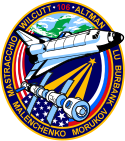Scott Altman
| Scott Altman | |
|---|---|
 | |
| NASA Astronaut | |
| Statsborger | USA |
| Nationalitet | Amerikansk |
| Status | Aktiv |
| Født | 15. august 1959 Lincoln, Illinois |
Andet arbejde | Jagerpilot |
| Uddannelses- sted | United States Naval Test Pilot School Naval Postgraduate School University of Illinois at Urbana-Champaign |
| Rang | Kommandør, USN |
| Udvælgelse | NASA-gruppen fra 1994 |
| Mission(er) | STS-90, STS-106, STS-109, STS-125 |
| Missionsemblemer | |
Scott Douglas Altman også kaldet Scott Douglas "Scooter" Altman (født 15. august 1959) er en NASA-astronaut og han har fløjet fire rumfærgemissioner, de to første (STS-90 og STS-106) som andenpilot, de to sidste som kaptajn (STS-109 og STS-125).
Før NASA fløj Scott Altman F-14 Tomcat fra hangarskibe.
Eksterne henvisninger
- NASA Biografi af Scott Altman (engelsk)
| Spire Denne biografi om en amerikaner er en spire som bør udbygges. Du er velkommen til at hjælpe Wikipedia ved at udvide den. |
|
Medier brugt på denne side
Scott Douglas Altman, US-American astronaut
Emblem of Nasa's STS-125 mission.
Emblem of Nasa's STS-109 mission.
This is the crew patch for the STS-106 mission, which is the first Shuttle flight to the International Space Station since the arrival of its newest component, the Russian-supplied Service Module Zvezda (Russian for star). Zvezda is depicted on the crew patch mated with the already orbiting Node 1 Unity module and Russian-built Functional Cargo Block, called Zarya (sunrise), with a Progress supply vehicle docked to the rear of the Station. The International Space Station is shown in orbit with Earth above as it appears from the perspective of space. The Astronaut Office symbol, a star with three rays of light, provides a connection between the Space Shuttle Atlantis and the Space Station, much the same as the Space Shuttle Program is linked to the International Space Station during its construction and future research operations. Stylized versions of flags from Russia and the United States meet at the Space Station. They symbolize both the cooperation and joint efforts of the two countries during the development and deployment of the permanent outpost in space as well as the close relationship of the American and Russian crew members.
STS-90 insignia
- The STS-90 crew patch reflects the dedication of the mission to neuroscience in celebration of the decade of the brain. Earth is revealed through a neuron-shaped window, which symbolizes new perspectives in the understanding of nervous system development, structure and function, both here on Earth and in the microgravity environment of space.
- The Space Shuttle Columbia is depicted with its open payload bay doors revealing the Spacelab within. An integral component of the mission, the laboratory/science module provided by the European Space Agency (ESA), signifies the strong international involvement in the mission. The seven crew members and two alternate payload specialists, Chiaki Naito-Mukai and Alexander W. Dunlap, are represented by the nine major stars of the constellation Cetus (the whale) in recognition of the International Year of the Ocean.
- The distant stars illustrate the far reaching implications of the mission science to the many sponsoring agencies, helping prepare for long-duration space flight aboard the International Space Station (ISS).
- The moon and Mars are depicted to reflect the crew's recognition that those two celestial bodies will be the next great challenges in human exploration of space and represent the key role that life science research will play in supporting such missions.






